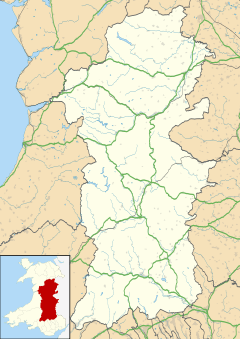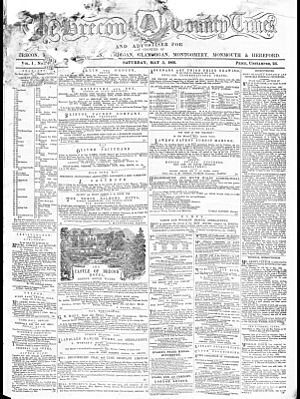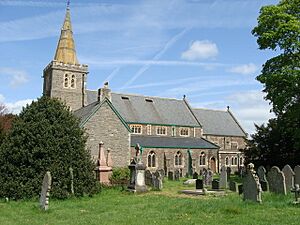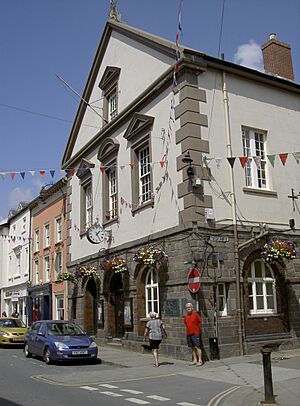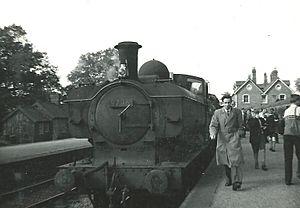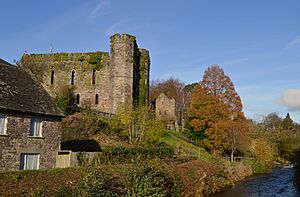Brecon facts for kids
Quick facts for kids Brecon
|
|
|---|---|
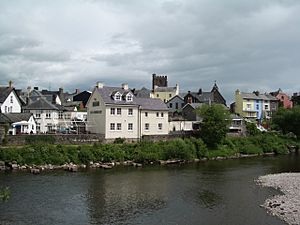 |
|
| Population | 8,250 (2011) |
| OS grid reference | SO045285 |
| Community |
|
| Principal area | |
| Ceremonial county | |
| Country | Wales |
| Sovereign state | United Kingdom |
| Post town | BRECON |
| Postcode district | LD3 |
| Dialling code | 01874 |
| Police | Dyfed-Powys |
| Fire | Mid and West Wales |
| Ambulance | Welsh |
| EU Parliament | Wales |
| UK Parliament |
|
| Welsh Assembly |
|
Brecon (pronounced like "Breck-on") is a busy market town in the middle of Wales. Its Welsh name, Aberhonddu, means "mouth of the Honddu River." Brecon is the third-largest town in Powys, a county in Wales. It sits just inside the beautiful Brecon Beacons National Park, north of the famous Brecon Beacons mountains.
For a long time, Brecon was the main town of Brecknockshire (or Breconshire). Even though its role changed when Powys was formed, it's still a very important local center for people living nearby.
Contents
Brecon's Story: A Look Back in Time
Early Days and Roman Times
The Welsh name, Aberhonddu, comes from the River Honddu. This river joins the River Usk right in the town center. Long ago, before bridges, Brecon was one of the few places where people could cross the Usk River easily.
The Romans built a cavalry base here called Y Gaer (or Cicucium). This base helped them conquer Wales. So, Brecon started as a military spot!
Norman Control and a Strong Castle
The spot where the Honddu and Usk rivers meet was perfect for defense. This is why a Norman castle was built there in the late 1000s by Bernard de Neufmarche. This castle still stands overlooking the town today.
In 1188, a famous priest and historian named Gerald of Wales visited Brecon. He gave speeches to encourage men to join the Crusades, which were religious wars.
Town Walls: Protecting Brecon
Brecon got its town walls after 1240, built by Humphrey de Bohun. These walls were made of stone and had four main gates. They also had ten round towers to help defend the town.
In 1400, the Welsh prince Owain Glyndŵr led a rebellion against English rule. To protect Brecon, the government spent money in 1404 to make the town's defenses even stronger. Most of Brecon's walls were destroyed during the English Civil War much later. Today, you can still see parts of them, like some earthworks and pieces of a gatehouse. These old parts are protected as important historical sites.
Important Churches and Cathedral
Brecon Cathedral
Brecon Cathedral is a special church. It became a cathedral in 1923, which means it's the main church for the Diocese of Swansea and Brecon. Before that, it was a priory, which is a type of monastery.
St Mary's Church
Saint Mary's Church started as a smaller chapel connected to the priory. Most of the building you see today is from later medieval times. Its tall West Tower, about 90 feet (27 meters) high, was built in 1510. It has eight bells that have been ringing since 1750! When the priory became a cathedral, St Mary's became the main church for the local people.
St David's Church
The Church of St David, often called Llanfaes Church, was likely built in the early 1500s. Its name comes from Welsh and means 'St David's in the field'.
Other Churches
Plough Lane Chapel, also known as Plough United Reformed Church, is a historic building. The current church was built in 1841. St Michael's Church is a Catholic church built in 1851. It was designed in a simple Gothic style.
Brecon's Military Role
Brecon has a strong connection to the military. The eastern part of town is home to two military bases:
- Dering Lines, where the Infantry Battle School is located. This is where soldiers learn important combat skills.
- The Barracks, Brecon, which is home to the 160th (Wales) Brigade.
About 9 miles (14 km) west of Brecon is the Sennybridge Training Area. This is a very important place for the British Army to train.
Where is Brecon?
Brecon is located in the Usk valley. This is where the Honddu and Tarell rivers meet the Usk. Two smaller hills are near the town: Pen-y-crug to the northwest and Slwch Tump to the east. Both of these hills have ancient Iron Age forts on top.
The town includes Brecon itself, which is on the north side of the Usk River, and a smaller area called Llanfaes on the south side. Llanfaes is built on the flat land near the rivers, and there are walls and banks to protect both parts of Brecon from floods.
How Brecon is Governed
Brecon has two levels of local government. There's the Brecon Town Council, which handles local town matters, and the Powys County Council, which manages the wider county. The Town Council works from the Brecon Guildhall on the High Street.
The town council chooses a mayor each year. In 2018, Emmanuel (Manny) Trailor became the first mixed-race mayor of Brecon.
Brecon has been an important town for a very long time. It was first called a "borough" in 1100. This meant it had special rights and responsibilities, like holding courts and managing the town's market. In 1536, Brecon became the main town for the new county of Brecknockshire. Over the years, the way the town was run changed, but it always remained an important local center.
Learning in Brecon
Brecon has several primary schools for younger children. For older students, there's a secondary school called Brecon High School. There's also a college, Brecon Beacons College, on the northern edge of town.
Brecon is also home to Christ College, an independent school that was started way back in 1541.
Getting Around Brecon
Brecon is a meeting point for two important roads: the A40, which goes east-west, and the A470, which goes north-south. The closest airport is Cardiff Airport.
The town's main bus station is the Brecon Interchange. You can catch long-distance buses here, as well as local buses that connect the town center with its different neighborhoods.
Canals and Rivers
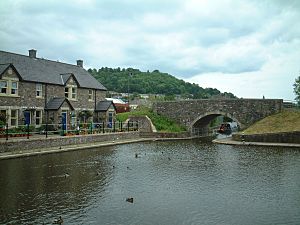
The Monmouthshire and Brecon Canal is a beautiful waterway that runs for about 35 miles (56 km) from Brecon. It was built between 1797 and 1812 to connect Brecon with Newport and the Severn Estuary. The canal area in Brecon was updated in the 1990s. Now, you can find boat moorings and Theatr Brycheiniog, the town's theater, there.
The Usk Bridge carries a road over the River Usk. A sign on a nearby house says the current bridge was built in 1563. It replaced an older bridge that was washed away by floods in 1535. The famous painter J. M. W. Turner even painted this bridge around 1769!
Old Railway Lines
Brecon used to have several railway lines. The Neath and Brecon Railway reached the town in 1867. There were also lines to Merthyr Tydfil and Llanidloes.
Another line, the Hereford, Hay and Brecon Railway, opened in 1864. Over time, different railway companies took over these lines. However, by 1962, all train services to Brecon had stopped. This happened even before the famous "Beeching Axe" report, which closed many railway lines across Britain.
Fun Things to Do and See
Brecon is a lively town with lots to offer!
- The National Eisteddfod, a big Welsh festival of culture, was held in Brecon in 1889.
- Every August, Brecon hosts the annual Brecon Jazz Festival. Musicians play in outdoor and indoor places, including the market hall and Theatr Brycheiniog.
- In October, you can enjoy the Brecon Baroque Music Festival, organized by the famous violinist Rachel Podger.
Brecon has even inspired poets and musicians! The town is mentioned in a poem by Idris Davies and later in a story by Dylan Thomas. This story was then turned into the famous song "The Bells of Rhymney" by Pete Seeger, which was also recorded by the Byrds.
Points of Interest
- Brecon Castle: Explore the ruins of this historic Norman castle.
- Brecon Beacons National Park Visitor Centre: Learn all about the amazing national park.
- Brecon Beacons Food Festival: Enjoy delicious local food.
- Brecon Cathedral: Visit this beautiful and historic church.
- Brecon Jazz Festival: Listen to great jazz music.
- Christ College, Brecon: See this old independent school.
- Regimental Museum of The Royal Welsh: Discover military history.
- Theatr Brycheiniog (Brecon Theatre): Catch a show or performance.
- Y Gaer: A modern cultural center with a museum and library.
Famous People from Brecon
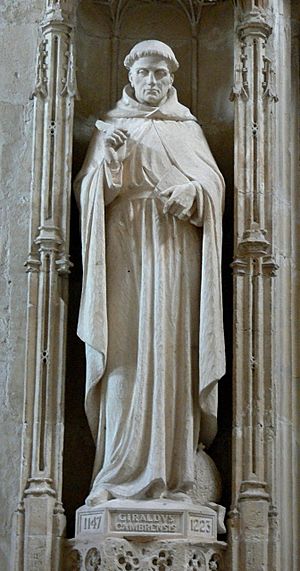
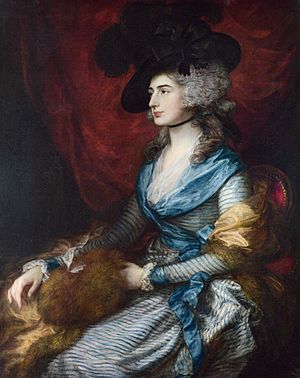
Many interesting people have connections to Brecon, including:
- Gerald of Wales (around 1146 – around 1223), a priest and historian.
- Dafydd Gam (around 1380 – 1415), an archer who fought in the Battle of Agincourt.
- Hugh Price (around 1495 – 1574), who founded Jesus College, Oxford.
- Henry Vaughan (1621–1695), a famous poet and doctor.
- Thomas Coke (1747–1814), the first Methodist bishop.
- Sarah Siddons (1755–1831), a very famous actress.
- Frances Hoggan (1843–1927), the first British woman to get a medical doctorate.
- George Melly (1926–2007), a jazz singer and writer.
- Roger Glover (born 1945), the bassist for the band Deep Purple.
- Nia Roberts (born 1972), an actress.
- Sian Reese-Williams (born 1981), an actress.
Sport
- Walley Barnes (1920–1975), a footballer for Wales and a broadcaster.
- Andy Powell (born 1981), a Welsh Rugby Union player.
- Jessica Allen (born 1989), a Welsh racing cyclist.
- Emma Plewa (born 1990), a footballer for the Wales women's national team.
Town Twinning
Brecon is "twinned" with several towns around the world. This means they have a special friendship and often exchange visits. Brecon is twinned with:
- Saline, Michigan, United States
- Blaubeuren, Germany
- Gouesnou, France
- Dhampus, Nepal
See also
 In Spanish: Brecon para niños
In Spanish: Brecon para niños


